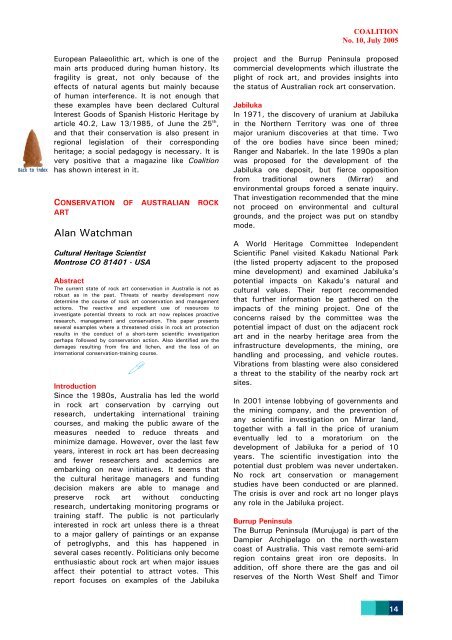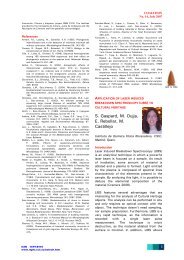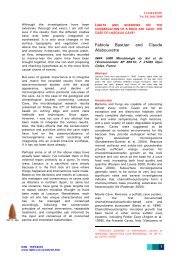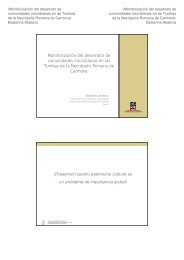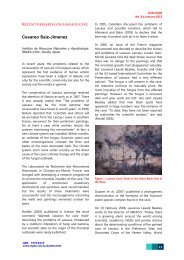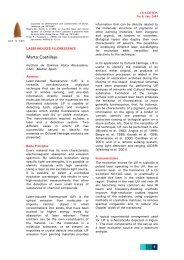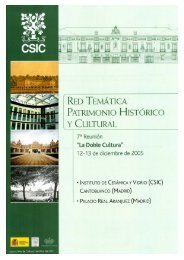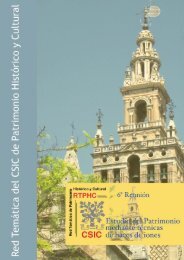Alan Watchman
Alan Watchman
Alan Watchman
- No tags were found...
You also want an ePaper? Increase the reach of your titles
YUMPU automatically turns print PDFs into web optimized ePapers that Google loves.
Back to indexEuropean Palaeolithic art, which is one of themain arts produced during human history. Itsfragility is great, not only because of theeffects of natural agents but mainly becauseof human interference. It is not enough thatthese examples have been declared CulturalInterest Goods of Spanish Historic Heritage byarticle 40.2, Law 13/1985, of June the 25 th ,and that their conservation is also present inregional legislation of their correspondingheritage; a social pedagogy is necessary. It isvery positive that a magazine like Coalitionhas shown interest in it.CONSERVATION OF AUSTRALIAN ROCKART<strong>Alan</strong> <strong>Watchman</strong>Cultural Heritage ScientistMontrose CO 81401 - USAAbstractThe current state of rock art conservation in Australia is not asrobust as in the past. Threats of nearby development nowdetermine the course of rock art conservation and managementactions. The reactive and expedient use of resources toinvestigate potential threats to rock art now replaces proactiveresearch, management and conservation. This paper presentsseveral examples where a threatened crisis in rock art protectionresults in the conduct of a short-term scientific investigationperhaps followed by conservation action. Also identified are thedamages resulting from fire and lichen, and the loss of aninternational conservation-training course.IntroductionSince the 1980s, Australia has led the worldin rock art conservation by carrying outresearch, undertaking international trainingcourses, and making the public aware of themeasures needed to reduce threats andminimize damage. However, over the last fewyears, interest in rock art has been decreasingand fewer researchers and academics areembarking on new initiatives. It seems thatthe cultural heritage managers and fundingdecision makers are able to manage andpreserve rock art without conductingresearch, undertaking monitoring programs ortraining staff. The public is not particularlyinterested in rock art unless there is a threatto a major gallery of paintings or an expanseof petroglyphs, and this has happened inseveral cases recently. Politicians only becomeenthusiastic about rock art when major issuesaffect their potential to attract votes. Thisreport focuses on examples of the JabilukaCOALITIONNo. 10, July 2005project and the Burrup Peninsula proposedcommercial developments which illustrate theplight of rock art, and provides insights intothe status of Australian rock art conservation.JabilukaIn 1971, the discovery of uranium at Jabilukain the Northern Territory was one of threemajor uranium discoveries at that time. Twoof the ore bodies have since been mined;Ranger and Nabarlek. In the late 1990s a planwas proposed for the development of theJabiluka ore deposit, but fierce oppositionfrom traditional owners (Mirrar) andenvironmental groups forced a senate inquiry.That investigation recommended that the minenot proceed on environmental and culturalgrounds, and the project was put on standbymode.A World Heritage Committee IndependentScientific Panel visited Kakadu National Park(the listed property adjacent to the proposedmine development) and examined Jabiluka’spotential impacts on Kakadu’s natural andcultural values. Their report recommendedthat further information be gathered on theimpacts of the mining project. One of theconcerns raised by the committee was thepotential impact of dust on the adjacent rockart and in the nearby heritage area from theinfrastructure developments, the mining, orehandling and processing, and vehicle routes.Vibrations from blasting were also considereda threat to the stability of the nearby rock artsites.In 2001 intense lobbying of governments andthe mining company, and the prevention ofany scientific investigation on Mirrar land,together with a fall in the price of uraniumeventually led to a moratorium on thedevelopment of Jabiluka for a period of 10years. The scientific investigation into thepotential dust problem was never undertaken.No rock art conservation or managementstudies have been conducted or are planned.The crisis is over and rock art no longer playsany role in the Jabiluka project.Burrup PeninsulaThe Burrup Peninsula (Murujuga) is part of theDampier Archipelago on the north-westerncoast of Australia. This vast remote semi-aridregion contains great iron ore deposits. Inaddition, off shore there are the gas and oilreserves of the North West Shelf and Timor14
COALITIONNo. 10, July 2005Sea. Open-cut mines were developed in the1960s and railway lines were built totransport the iron ore to deep water ports.Depuch Island was selected as a suitable portlocation and the Western Australian Museumconducted an impact study of the island.After finding an extensive array of petroglyphsthe Museum recommended that developmentof the site not proceed. Instead loadingfacilities were built at Dampier despite thepresence of much more rock art in the vicinityof the Dampier facilities than on DepuchIsland.yet it does not have World Heritage status. Aninventory of the rock art has not beencompiled. There has been no regularmonitoring of rock art sites and no ongoingresearch. Federal and State governments havenot been concerned about the stability orprotection of the petroglyphs, and there is noplan of management for the region (Bednarik,2002).The reason that the rock art is now in publicfocus is because further gas and chemicalplants are planned for construction and therock art will once again be impacted. Thechemical plants will produce nitrogen andsulphur oxides, and ammonia gas emissionsand these artificial by-products may enhancethe deterioration of the petroglyphs. In 2004 astudy of the chemical effects on the surfaceof the rock art was commenced (MacLeod,2005), but the planned development is likelyto proceed for economic reasons.Figure 1. Example of rock carving on the Burrup Peninsula.Courtesy Robert BednarikIn the 1980s and following the discovery ofthe North West Shelf natural gas reserves atreatment plant and loading facilities werebuilt on a small part of the Burrup Peninsula.During that development some petroglyphswere destroyed and others moved to a fencedcompound. Little conservation work wasundertaken and limited recordings were made.No scientific investigations of weathering anddeterioration were carried out.Figure 2. Rock art of the Burrup Peninsula. Courtesy RobertBednarikThe Burrup Peninsula contains hundreds ofthousands of figures and may be the largestconcentration of petroglyphs in the world andFigure 3. Recent rock carving on the Burrup Peninsula. CourtesyRobert BednarikThe scope of the research involves modellingthe predicted and known ground level ambientconcentrations and the deposition rates ofnitrogen dioxide, sulphur dioxide and ammoniafrom the existing and proposed industrial andshipping sources. The mineralogy andchemistry of the rock types will be studiedwith the aim of determining the natural andpossible accelerated weathering rates. Othertopics of study include the examination ofcolour and physical changes to theengravings, the microclimate, atmosphericdeposition and microbiological activity. Areport is expected from the researchmanagement committee in 2007.Part of the scientific study is being undertakenby research teams that do not have priorexperience with rock art conservation. Some15
COALITIONNo. 10, July 2005conservation scientists are involved inmanaging the project and this should ensurethat appropriate recommendations are made.The major concern is that more petroglyphswill be physically and chemically damaged tothe extent that they will be lost from thecultural heritage record.WildfiresAs in many dry countries, the damage causedby wildfires not only affects infrastructure andpeople’s lives, but also rock art. During recentyears in Australia, and particularly along theeast coast wildfires have wreakedconsiderable damage to property and naturalareas. In January 2000, a wildfire sweptacross the Australian Capital Territory andburnt many homes in Canberra. The fire alsoseverely damaged the Rendezvous Creek rockart location in Namadgi National Park(<strong>Watchman</strong> et al., 1995; <strong>Watchman</strong>, 2003). Awooden viewing platform had been builtwithin a domed granite tor to protect thearchaeological deposit and to minimize dustfrom tourist traffic. The localized heat fromthe burning of the platform generated severestresses within the existing weathered surfaceand large areas of adjacent rock spalled off.shelter is now part of the current managementstrategy.DustAn additional problem at that site and manyothers is the gradual accumulation of dustfrom natural sources, such as wind blownparticles, and animal and occasional humanfoot traffic (<strong>Watchman</strong>, 2002). Oftenindigenous people painted those stable rocksurfaces and now a dust film partly obscuresthe paintings. The cleaning of the surfaces isnot generally undertaken, and it has onlypreviously been carried out once before(Haskovec, 1990). The removal of theaccumulating dust on the Rendezvous Creekpaintings is not a conservation or managementpriority. Dust removal is also not a highpriority at other locations.Figure 5. View of the dark dusty surface at Rendezvous Creekrock shelter showing the red and partly obscured white paintingsFigure 4. Entrance to the Rendezvous Creek rock shelter showingthe large spalled blocks that collapsed during the intense burningof the wooden viewing platform (shown by the blue plastic sheet)Additional cracking occurred and new strainsinitiated in the granite. Most of the paintingswere relatively unaffected because they wereat the back of the shelter and distant from theburning platform. The managers are focusingon erecting in the shelter another woodenstructure similar to the previous one, but otheroptions include building a metal viewingplatform and closing the site to touristsbecause of potential instability. The regularmonitoring of the walls and ceilings of theOne success story occurred at the Split Rocksite in north Queensland where conservationscience established that dust particles fromthe unpaved road nearby were settling on rockpaintings (<strong>Watchman</strong>, 1998). A result of thatresearch and because of pressure on thegovernment the laying of asphalt paving overseveral kilometers of road either side of therock art site eliminated the dust problem.Current ResearchWhile some rock art research is underway inAustralia there is not as much as in the past.The Burrup Peninsula case is one majorproject. Bruce Ford, a graduate of the jointGetty Conservation Institute and University ofCanberra Rock Art Conservation course(Stanley Price, 1990, 1991), is studying thegrowth rate of lichen in rock shelters andinvestigating novel ways to control theirspread (Ford, 2005). His work in a remote16
COALITIONNo. 10, July 2005rock shelter without any paintings in NamadgiNational Park is another scientific study intoways to conserve Australian rock art, butthere are few other current projects.A major research project into the nature oforganic substances and the formation ofoxalate rich coatings at rock art sites inAustralia has now ended with the terminationof a fellowship to this author. That research,over five years provided extensive insightsinto the existence of natural oxalate richcoatings formed through microbiologicalpathways (<strong>Watchman</strong>, 2001a,b, 2004;<strong>Watchman</strong> et al., 2005). It also providedmany age determinations for rock paintings,cupules and tracks, not only in Australia (Coleand <strong>Watchman</strong>, in press), but in Africa (Mazeland <strong>Watchman</strong>, 1997, 2003) and Mexico(<strong>Watchman</strong> et al., in preparation). Flowing outof the research were various contributions tounderstanding the stability and condition ofpaintings and rock carvings. Such importantoutcomes have affected management andconservation decisions at numerous rock artsites in Australia and elsewhere.reputation of the course and for purelyrevenue to cost reasons closed the CulturalHeritage Science unit. In 1989, the universityhad organized and taught the first and onlyinternational rock-art conservation course, andanother short program of training was underconsideration. Abandoning those plans nowleaves Australia without any established rockart conservation-training forum.ConclusionsThe dismal state of rock art conservation inAustralia reflects a change in attitude bypoliticians, park managers, granting bodiesand the public. Reactive management is invogue and not proactive research,conservation and planning. This approachsaves money. Specialist advice becomespolitically or economically expedient and onlyfor development projects where rock art isunder threat. A major problem will arise in thefuture when the current rock art specialistsretire without adequate replacements. We willthen return to the situation in the 1980s whenthere was a shortage of knowledge andspecialists in rock art conservation inAustralia. The void, which is occurring, willrequire a new generation to take up thechallenges of conserving Australia’s rock artheritage.AcknowledgementsI thank Robert Bednarik for providing theBurrup Peninsula photographs. Please visitthe web site and sign the petition to save theDampier rock art:http://mc2.vicnet.au/home/dampier/web/index.htmlFigure 6. Nursery Swamp rock shelter showing the monitoringequipment used to determine environmental factors in relation tothe growth of lichenTrainingAn end of an era in the training ofconservators in Australia occurred with theclosing of the University of Canberra’spostgraduate program. This disappointingevent resulted from financial decisions by theuniversity which considered the courseuneconomic. The qualified conservators whograduated from the internationally recognizedcourse always found employment at museumsand galleries around the world. The universitynever acknowledged the high quality ofprofessional training and the excellentReferencesBednarik R.G. (2002). Dampier Petroglyphs: Call for Urgent Help(Australia). International Newsletter on Rock Art 34: 7-10.Cole N. and <strong>Watchman</strong> A. (2005). Early Man Revisited: adiscussion of recent rock art dating research in the Lauraregion, Cape York Peninsula, Australia. Antiquity (in press).Ford B. (2005). Micro-environmental study of lichen invasion at aNgunnawal Aboriginal rock art site in the Eastern Australiansub-alpine region. Conference Paper, Mural Paintings, Mosaicsand Rock Art, ICOM-CC 14 th Triennial Meeting, 12-16September 2005, The Hague, Netherlands.Haskovec I.P. (1990). Rock Art Conservation in Kakadu NationalPark, Northern Australia. In Journees Internationales d'Etudesur la Conservacion de l'arte Rupestre, Perigord, France, pp.75-88.Macleod I.D. (2005). The effects of moisture, micronutrientsupplies and microbiological activity on the surface pH ofrocks in the Burrup Peninsula. Conference Paper, MuralPaintings, Mosaics and Rock Art, ICOM-CC 14 th TriennialMeeting, 12-16 September 2005, The Hague, Netherlands.Mazel A. and <strong>Watchman</strong> A.L. (1997). Accelerator radiocarbondating of Natal Drakensberg paintings: results andimplications. Antiquity 71: 445-449.Mazel A.D. and <strong>Watchman</strong> A.L. (2003). Dating the rock paintingsin the uKhahlamba-Drakensberg and the Biggarsberg,KwaZulu-Natal, South Africa. Southern Africa Humanities 15:59-73.17
COALITIONNo. 10, July 2005Stanley Price N.P. (1990). Rock Art Conservation: GraduateCourse at Canberra. Getty Conservation Institute Newsletter2: 4.Stanley Price, N.P. (1991). Training for Rock Art Conservation:Recent Initiatives of the Getty Conservation Institute. In RockArt and Posterity. Conserving, Managing, and Recording RockArt. Part 1: Rock Art Conservation and Site Management.Occasional AURA Publication 4. Australian Rock Art ResearchAssociation, Melbourne, Australia, pp. 100-103.<strong>Watchman</strong> A. (1998). Composition and source of dust on SplitRock paintings, Australia. Rock Art Research 15: 36-40.<strong>Watchman</strong> A. (2001a). Wargata Mina to Gunbilmurrung: the directdating of Australian rock art. In A. Anderson, I. Lilley and S.O’Connor (eds), Histories of Old Ages: Essays in honour ofRhys Jones. Pandanus Books, Research School of Pacific andAsian Studies, the Australian National University, Canberra,pp. 313-325.<strong>Watchman</strong> A. (2001b). Dating oxalate minerals in rock surfacedeposits. In M. Jones and P. Sheppard (eds), ProceedingsAustralasian Archaeometry Conference. February 2001,Auckland, pp. 404-411.<strong>Watchman</strong> A. (2002). The impacts of dust on rock art sites innorthern Australia. Proceedings of the conference L’art avantl’histoire: la conservation de l’art préhistorique, pp. 25-34.SFIIC, Champs sur Marne, France.<strong>Watchman</strong> A. (2003). Impacts of fire at the Rendezvous Creekand Nursery Swamp sites, Namadgi National Park. A.C.T.Unpublished report to the Department of Environment.A.C.T., Canberra.<strong>Watchman</strong> A. (2004). Minimum age for a petroglyph on a boulderof significance in southern Kakadu National Park, NorthernTerritory, Australia. Rock Art Research 21: 187-195.<strong>Watchman</strong> A., Gutiérrez M.L. and Hernandez Llosas M. (2005).AMS radiocarbon age determinations for paintings andpetroglyphs in Baja California Sur, Mexico. Antiquity (inpreparation).<strong>Watchman</strong> A., O’Connor S. and Jones R. (2005). Dating OxalateMinerals 20-45 ka. Journal of Archaeological Science 32:369-374.<strong>Watchman</strong> A., Sale K. and Hogue K. (1995). Conservation of theRendezvous Creek and Nursery Swamp 2 Aboriginal PaintingsSites, Namadgi National Park, A.C.T. Conservation andManagement of Archaeological Sites 1: 25-31.Back to index18


